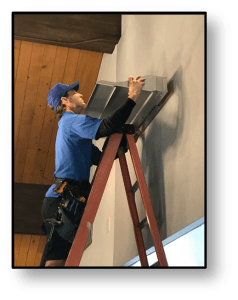
By Joe Kalman
When a congregant suggested that the Church of Foothills in Ventura, California, could quickly and affordably leverage the same UV disinfection technology as LAX International Airport, Louis Vigorita was immediately sold.
It helped that the congregant was both a respected physician and public health researcher who was fresh from discovering the technology while passing through New York’s Syracuse Airport on a trip.
While traveling to a family wedding, long-time church member Nancy Merrick, MD, MSPH, spotted the UV disinfection fixtures—about the size and length of two shoeboxes—mounted near the ceiling throughout the TSA security screening area at Syracuse Hancock International Airport (SYR).
AIRPORT-INSPIRED DISINFECTION
Dr. Merrick spoke with TSA staff about the blue-light fixtures mounted near the ceiling of the Airport’s security checkpoint. She learned that germicidal UV‑C fixtures could be found in many hospitals, municipal facilities, sports arenas, commercial lobbies, and other high-traffic communal areas.

Upon returning home to Ventura, Dr. Merrick conducted further research that showed UV‑C had been used
successfully for decades to disinfect air, water and surfaces. It has also proven effective in reducing the transmission of TB and Measles. It’s also endorsed by the U.S. Centers for Disease Control & Prevention to reduce infectious aerosols.
When Dr. Merrick approached Vigorita, she had already identified UV Resources, the California-based manufacturer of UV disinfection technology used at the Syracuse, Dallas Fort Worth and Los Angeles International Airports. In fact, UV Resources’ founders pioneered the application of UV‑C energy in HVAC equipment nearly 25 years ago to address a different pandemic-of-sorts, sick building syndrome, in the early 1990s.
PROTECTING CONGREGANTS
“Like any facility manager, we wanted to safeguard our parishioners, clergy and lay leadership from airborne viruses and get back to our in-person fellowship,” notes Vigorita, former president of the Church’s Board of Facilities. “Nancy brought us an effective and affordable method for reducing COVID-transmission that was swiftly approved by our governing board.”
Everyone was frustrated that the COVID-19 Pandemic forced parishioners into their home computers and away from our close-knit community, explains Vigorita.
“When in-person services resumed, Nancy would bring a carbon dioxide monitor into the sanctuary to help us measure ventilation levels and safeguard our congregants,” explains Vigorita. “When CO2 levels rose to a certain level, we would open windows and doors and adjust portable fans to improve the room’s ventilation levels. Sometimes these actions proved unpopular and uncomfortable, especially on very hot or cold days.”
UV-C INACTIVATES PATHOGENS IN NEAR CEILING

Once church administrators approved the use of UV disinfection, Vigorita turned to germicidal specialist Jim Edson, with Santa-Clarita-based NUView Environmental, who recommended the GLO™ series of Upper‑Room UV‑C fixtures from UV Resources.
After conducting a site visit, Edson specified two types of upper-room UV‑C units to protect the church’s 50×37-foot, 200-person sanctuary.
Two GLO-225 baffled or louvered-type luminary were mounted above occupants’ heads on either side of the rectangular sanctuary. At the same time, a GLO-1500 open-ended fixture was installed at the rear of the worship area, where UV-C energy blankets the upper air in the cathedral ceiling. Both fixtures utilize an exclusive, high-spectral parabolic reflector system to maximize germicidal output levels.
HOSPITAL-GRADE DISINFECTION
“It’s the same type of UV disinfection technology that we’ve installed extensively at nine Los Angeles community colleges,” explains Edson. “While hospitals and schools have used UV disinfection technology since the 1930s to control airborne infectious diseases, its application in houses of worship, dormitories, restaurants and courthouses is relatively new.”
One installation challenge was positioning the fixtures so the UV-C energy was safely above the church’s 30-member choir loft. Edson and his team adjusted the angle of the UV fixture closest to the choir loft and used a UV radiometer to ensure no stray light entered the occupied portion of the sanctuary. All fixtures were then safety tested to meet CDC guidelines.
The upper-room fixtures leverage the continuous natural rise-and-fall of convection or mechanical air currents to lift airborne infectious agents overhead, where they are inactivated by UV-C energy.
“The safety of our church community is our top priority and we ‘ve taken multiple measures to mitigate risks to our congregants,” says Vigorita. “Since we installed the UV disinfection systems, our congregation has had no outbreaks. UV disinfection is a proven and nontoxic means of reducing the risk of airborne disease so the air we breathe is safer.”
 Joe Kalman is the Director of Sales for UV Resources. He works with leading facilities management companies, HVAC engineers, and has written and presented on such topics as indoor air quality, how to leverage ROI from germicidal UV-C and HVAC sustainability issues. He may be contacted at Joe.Kalman@UVResources.com.
Joe Kalman is the Director of Sales for UV Resources. He works with leading facilities management companies, HVAC engineers, and has written and presented on such topics as indoor air quality, how to leverage ROI from germicidal UV-C and HVAC sustainability issues. He may be contacted at Joe.Kalman@UVResources.com.


